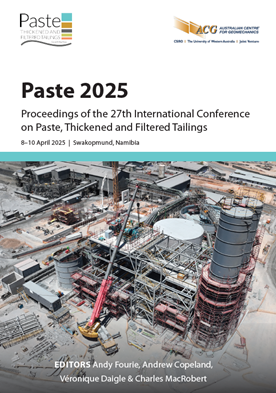Ensuring efficient tailings treatment: the importance of optimal flocculant dissolution

|
Authors: Bonnier, J; Gathier, F; Matinin, A; Geneyton, A |
DOI https://doi.org/10.36487/ACG_repo/2555_05
Cite As:
Bonnier, J, Gathier, F, Matinin, A & Geneyton, A 2025, 'Ensuring efficient tailings treatment: the importance of optimal flocculant dissolution', in AB Fourie, A Copeland, V Daigle & C MacRobert (eds), Paste 2025: Proceedings of the 27th International Conference on Paste, Thickened and Filtered Tailings, Australian Centre for Geomechanics, Perth, pp. 89-104, https://doi.org/10.36487/ACG_repo/2555_05
Abstract:
Mining activities generate large quantities of tailings that require effective treatment before disposal to minimise environmental impact. Flocculants play a critical role in this treatment, by improving solid–liquid separation (such as thickening or filtration), and by enhancing water clarification. While proper preparation is crucial for all forms of flocculant, this paper focuses on powder and the importance of optimised dissolution for an efficient treatment. State-of-the-art preparation techniques ensure all available polymer is working effectively, translating into enhanced flocculant efficiency, reduced consumption, and improved overall process stability. Conventional flocculant makedown systems have been used for decades with various methods of mixing (eductor, wetting head, etc.) and often perform adequately. However, inefficient dissolution of powder flocculants can occur in a non-negligible number of cases (limitation of conventional dissolving technologies, increase of tailings flow to treat, low-temperature water, etc.) and leads to several drawbacks. Undissolved clumps (known as fisheye) form, reducing the available active polymer and hindering particle bridging. The required dissolution time can be lengthy, impacting process efficiency and increasing capital and operational costs. Additionally, inconsistent flocculant concentration occurs over time and disturbs the dewatering process. These issues ultimately lead to increased flocculant consumption and reduced treatment performances. While various factors can impact dissolution, such as water quality, temperature, type of flocculant and concentration of preparation, a novel piece of equipment – the Polymer Slicing Unit (PSU™) – offers a promising solution. The PSU addresses these challenges by ensuring proper dispersion and wetting of powder flocculant in water (generally 50% faster than conventional systems), even at high concentration (up to 1.5%), eliminating fisheyes and maintaining a stable concentration for consistent dewatering. In summary, optimised flocculant dissolution is essential for efficient tailings treatment, particularly for powder flocculants. Implementing proper preparation techniques and exploring innovative technologies like PSU can significantly improve treatment performances and associated costs.
Keywords: flocculant, dissolution, makedown system, tailings, solid–liquid separation
References:
Brown, DW 1987, ‘The effect of make-up procedure on the efficiency of flocculant solutions’, International Journal of Coal Preparation and Utilization, vol. 4, no. 1–2, pp. 51–78.
Castillo, C, Fawell, P & Costine, A 2023, ‘Optimising the activity of acrylamide-based polymer solutions used to flocculate mineral processing tailings suspensions – A review’, Chemical Engineering Research and Design, vol. 199, pp. 214–237.
Croft, P 1975, Mixing Apparatus and Method, Patent US4086663A, Allied Colloids Ltd, Bradford.
Owen, AT, Fawell, PD, Swift, JD & Farrow, JB 2002, ‘The impact of polyacrylamide flocculant solution age on flocculation performance’, International Journal of Mineral Processing, vol. 67, no. 1-4, pp. 123–144.
Owen, AT, Fawell, PD & Swift, JD 2007, ‘The preparation and ageing of acrylamide/acrylate copolymer flocculant solutions’,
International Journal of Mineral Processing, vol. 84, pp. 3–14.
Rivas, C & Bonnier, J 2021, Device for Dispersing Water-Soluble Polymers, Patent EP4186585A1, SNF Group, Andrézieux-Bouthéon.
SNF 2019, FLOQUIP Polymer Make-up Equipment, Athens.
© Copyright 2025, Australian Centre for Geomechanics (ACG), The University of Western Australia. All rights reserved.
View copyright/legal information
Please direct any queries or error reports to repository-acg@uwa.edu.au
View copyright/legal information
Please direct any queries or error reports to repository-acg@uwa.edu.au
